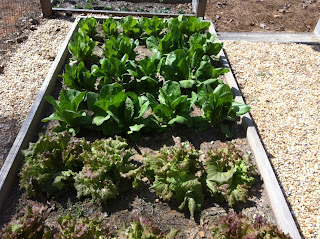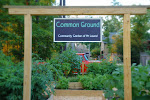Monday, March 19, 2012
Monday, June 1, 2009
We've got an EXCEPTIONAL PROJECT coming up...
Wednesday, April 22, 2009
Our 2nd Project - A Garden for Someone Else !
After brief conversation with Stacey, I sensed an idea coming on. Why not apply our talents to helping not only Girls Inc, but others build their own Community Gardens ? I agreed to help Girl's Inc. with their project, and planned a visit to their facility to assess the site. Two weeks later, I visited the site and saw that they had an awesome, sun filled area - perfect to build a garden about twice as large as the one we had constructed in Mt Laurel. Once we had mapped out a plan for the garden, I then determined what supplies we would need and began contacting folks to raise funds to build the garden. Stacey also had some contacts, and between the two of us we raised the funds necessary to get the garden built. Shown below are some of the photos from the construction phase of this project.
A great team of folks helped make the Girl's Inc. dream a reality - Kris Dunn, Scott Stone, Michael Wolfe, and Ken Morton. THANKS FELLAS !!!
The larger space allowed us to construct a sort of "Hallway" thru the garden - a future home for grape vines and muscadine vines.
At the completion of the project, our decision to help other people build their Community Gardens was finalized. And that's where we stand today - ready, willing, and able to help you !
A Look at the Garden - Mid Summer
Using tomato cages is highly recommended - they support the growing plants as well as providing for a neater and cleaner appearance. An added benefit - they keep the fruit from coming into contact with the ground.
Monday, March 9, 2009
Common Ground - Now We Are Getting Somewhere
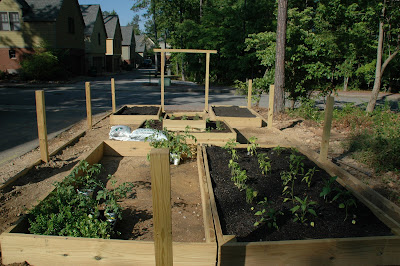

After the first two weekends of work, Common Ground was really starting to take shape. The beds were built, set in place, and filled with our manure/topsoil mixture. The garden sign was ordered. The plant selection had begun - and excitement was running high. As you can see in the above photo, planting was in progress - we could not wait to fill all the beds before we gave our nascent vegetable plants a new home
We had some great help in the form of neighbors David and Miles Brush.



Once the beds are secured in place, the next step is to begin filling them with your planting mixture. As mentioned earlier, we prefer a mixture of half topsoil and half pasteurized manure - both available in bagged form. This mixture is plenty rich for your plants and helps ensure that weeds are not a problem.

Building Common Ground - Literally

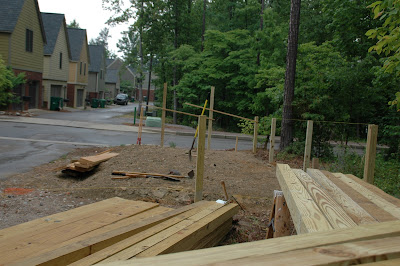
In the beginning, we started with a sunlit piece of ground, and a lot of hard work ahead of us. The first steps were to map out the garden, and then set the posts which would define the perimeter.
Rarely is a plot of ground perfectly level, but making sure that your perimeter posts are "square" and that the tops are all level is key.

In the above photo, you will notice that we built a perimeter of 2x10's which function as sort of "baseboards. They also act as a structural element and provide a nice,clean, finished look to the project. Raised beds are constructed of 2x10,s (altho 2x12's work fine) - they are assembled, then set in place. Once they are set, short 4x4/s are set into the corners to provide stability and ensure that the beds remain stationary.

A nice, attractive entrance is also an important element. This can be accomplished easily with longer 4x4's and a little creativity.
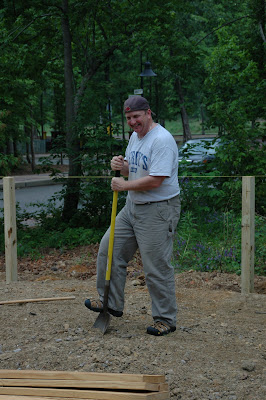
Yours truly hard at work early on in the project.
How Common Ground Produce came to be.....
“Common Ground”… it’s a phrase that appeals to everyone. It suggests a place where we all get along, and partake willingly from it’s inherent bounty. That’s the idea behind the new Community Garden at Mt Laurel. It’s there for everyone’s enjoyment and benefit, it belongs 100% to every resident, and 0 % to any individual – and soon the harvest will begin and the fruits borne from this “Common Ground” will spread their message throughout the town.
The idea of a Community Garden was first contemplated in the winter of 2004, when a small group of 10 people got together to discuss ideas for a garden that all of Mt Laurel could share in and enjoy, one which everyone could both learn and harvest from. The families Stone, Jackson, Thompson, Brush, and Tickle put their collective heads together and came up with a plan. However, as is often the case, life got in the way… one family moved, some babies came, and the plan was put on the shelf. However, the spark remained.
On one cold November day of 2006, the spark flickered. Chris and Scott Stone were looking out the window of their library, pondering a variety of subjects, and the topic of the garden was resurrected. Many things were debated - possible locations , obstacles that had to be overcome, resources needed, whether the garden would be accepted by the town, was there enough sunlight, would future development create problems, what would be planted, who would harvest and maintain, how would irrigation be provided … the list grew and grew, but the progress was undeniable. In March 2007, Alabama experienced an early taste of spring, and the spark became a flame –others were becoming interested. Kelley Burley voiced an interest in a community garden to Rip Weaver, Town Landscape Architect. Rip referred Kelley to the Stones, and a commitment was made to bring the 3 year old idea to fruition.
First, a location had to be selected. It had to be one which allowed for full sunlight, required minor modifications, provided easy access to water, was visible and accessible to the residents, and one which was not the near term target for development. Once a site was selected, it was presented to John Freeman and Rip Weaver – who gave their full endorsement of the project. The garden would be built on Abbot, between Olmsted and Hawthorn.
From there, things began to move quickly – a site layout was developed by Chris Stone, Mt Laurel provided the site prep and fill dirt, and a list of materials needed to build the garden was developed.
It was determined early on that we would adhere to the following guidelines:
- All planting would exist in wooden raised beds filled with 2/3 topsoil and 1/3 organic matter.
- We would use organic and pesticide free measures whenever possible.
- We would plant for the benefit of everyone in Mt Laurel, regardless of who contributed the efforts to grow the crops or construct the garden.
- The beds will be kept neat and weed free. All residents would be encouraged to assist in this endeavor.
- We would focus our plantings on items which had a high ratio of yield to space requirement (e.g. tomatoes rather than string beans, squash rather than melons)
In early May, the site prep was complete, building materials were delivered, and construction of the garden began in earnest. As this took place, people around the town were taking notice – questions about what was happening, interest in the Garden, and volunteers to assist were all the topics of emails within the town. With construction led by the Stones, many people provided their efforts as well. Scott Prescott, David Brush, Miles Brush, and Jon Thompson were among the early contributors – soon to be followed by Wilson Parker, Cade Kuykendal, Bob Kuykendal, and Davis Parker. Working on weekends and after work, the construction progressed smartly, and soon beds were built, staked, and planted. Tomatoes, squash, peppers, okra, basil, thyme, parsley, purple sage, and cilantro all were among the first plantings. A “Kids Garden” was also built, where the young gardeners of Mt laurel will be encouraged to plant seeds of their choice and watch them grow.
While much work remains before the garden is complete (installation of fencing, construction and installation of gate), talk has already begun about fall planting and a pumpkin growing contest. While we look to the future of our nascent garden, it’s important that we recognize the efforts of the original 10 “founders” of the garden, as well as John Freeman and Rip Weaver – all of whose efforts and willingness to make this a reality were essential to the progress thus far.
Clearly, the future of the Mt Laurel Community Garden is bright – and the formation of something special… another piece of “Common Ground, has taken place.

